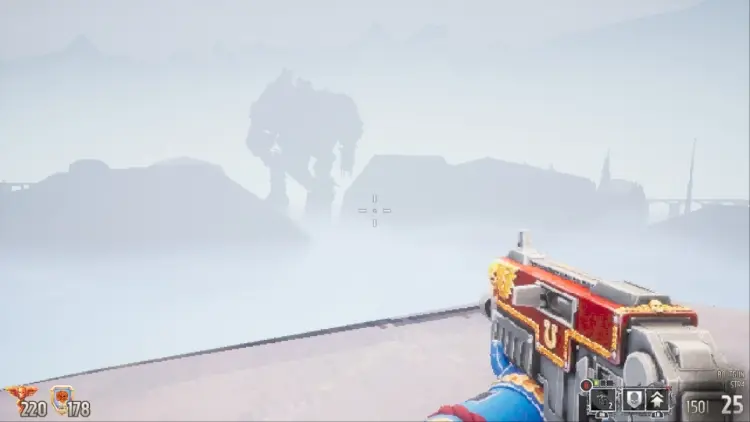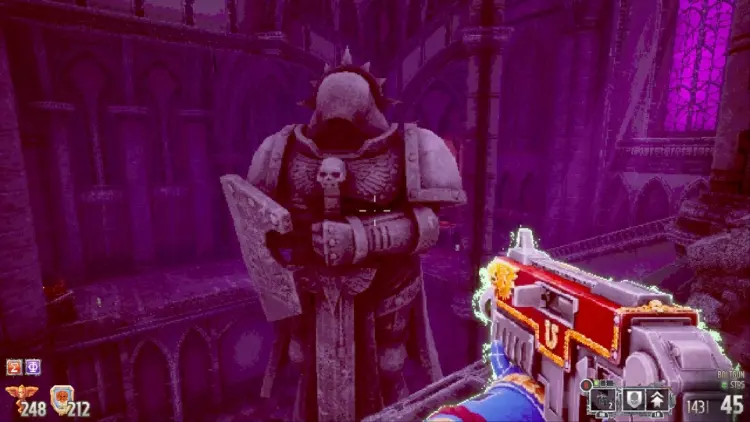
Warhammer 40k: Boltgun - Review
In the grim darkness of the far future, there is only war
Boltgun is a great time, although I wish it’s creators had pushed for something a little more unique. Ultimately I recommend this game.
I love the Warhammer 40k universe; it provides a grand canvas for stories. For example, in Boltgun, when you drop onto the forge world of Graia as Malum Caedo, a space marine of the Ultramarines chapter it has already set an epic scene with a rich backstory.
Graia, the forge world itself, is an entire planet dedicated to producing and refining war machines. Here the countless factorum of the Adeptus Mechanicus toil endlessly in service to their machine god, The Omnissiah, in an attempt to comprehend its glory. So fervently do they toil at this work that the ecosystems on their forge worlds are nearly always destoyed, making them toxic wastelands.
Space Marines, also known as Adeptus Astartes, are the elite super-soldiers of the Warhammer 40k universe. Genetically enhanced, they are physically superior to ordinary humans, with immense strength, resilience, and a near unlimited lifespan unless they are slain in battle. An average space marine clad in massive power armor and armed with advanced weaponry, comes in at 7-8’ tall, and weights 1,100 - 2,200 lbs depending on armor type, they are humanity’s foremost defenders against the threats that beset the Imperium of Man. Malum Caedo, as a member of the Ultramarines, also inherits the chapter’s rich history. As one of the original chapters, the Ultramarines have protected the Imperium of Man for over 10,000 standard years.
The Warhammer 40k universe is full of epic history; there are also many YouTube channels dedicated to covering it. I am a particular fan of Luetin09; if any of what I have written here has sparked an interest, do yourself a favor and listen to some more lore.
Boltgun’s place in the Warhammer setting
Graia is also the planet that Captain Titus liberated from an Ork invasion in Warhammer 40,000: Space Marine way back in 2011. So Boltgun provides a welcome return to the setting before the second game, Warhammer 40,000: Space Marine 2, is released later in 2024.
The Bolter or Boltgun is one of the most iconic weapons in the 40k universe. The boltgun comes in several sizes but is primarily manufactured for use by the Space Marines. The most common bolter pattern fires .75 caliber, rocket-propelled rounds that pierce the target’s outer layer of armor and then explode, turning the target into a bloody mess of soup. The recoil alone would cause serious injury if an average-sized human attempted to fire it, not to mention the deafening roar of the weapon’s oversized ammunition.
The boltgun is seen as an instrument of the Emperor’s wrath by the individuals who wield it, and in Boltgun, I can see why they view it this way. You will find many different weapons throughout the game. Still, I always found myself returning to the standard Boltgun, or when a more challenging enemy came along, I pulled out the Heavy Bolter.
Game Impressions
Boltgun is the first of the new Boomer Shooters genre I’ve tried out, and if the rest are anything like this one, I will have to play some more of them. Before you take issue with the genre, you should know that it’s got nothing to do with the generation by the same name; these games simply feature lots of explosions.
There are 3 chapters in the game, each composed of 8 missions. Depending on the difficulty and how much time you spend looking for secrets, it will probably take 8-15 hours to complete the game. There is no map and almost no guidance from objective to objective, so a large part of my time with the game was spent running around trying to find keys or the doors that said keys open. This isn’t always a bad thing, as that’s a common feature of this shooter style from back in the day, but on some of the larger levels, it got annoying.
In the grim darkness of the far future, there are no maps, and every corridor looks the same…
When I booted up the first level, I was transported back to the first time I played Wolfenstein 3d or the original Doom. I realized I miss those simpler experiences, and they have a place in today’s games. The graphics are blocky enough to conjure up feelings of nostalgia but still good enough to be enjoyable. The game looks at your memories of the old shooters, not how they actually looked.
The gameplay loop is about what you expect: bad guys show up in droves, and you explode them into gory little bits. The arsenal of guns is varied and exciting; each has a scenario where it shines. You can also access a chainsword, an epic amalgamation of sword and chainsaw. When you target an enemy with it, they are highlighted in red, and game time slows down, then Malum leaps forward and spectacularly eviscerates them. If you’re having difficulty with the game, you should get used to this move, as it gives you an excellent way to close the gap on enemies while reducing the damage they deal. You can also charge enemies, which literally sees you run into the enemies in your path, sending them flying off into walls or further down the hall. I found this attack most useful against the myriad of nurglings that seem to swarm you so often, literally using your armored form as a weapon. One added fun note is that if you fall on enemies from high enough, they explode into gory little bits. You take no falling damage as far as I was able to test.

The health and armor systems are mostly what you will have seen in other places. You have a health and armor pool stocked by picking up powerups around the map. However, instead of armor, they call it contempt, which plays into a 40k concept that you can armor yourself with the contempt of your enemies, which is a fun piece of world-building.
My armour is contempt!
Sound Design
The game sounds great; the soundtrack gets your blood pumping for more gory action. The guns sound chunky, with some weight to their firing noises.
Steam Deck with External Controller
I played through the entirety of the game on my Steam Deck OLED, docked to my TV with an 8Bitdo Ultimate controller. The game runs quite well on the deck; I noticed very few hiccups or stutters except for during the largest fights later on in the game. The controller felt good for the most part, with a decent control layout.
My biggest complaint about playing with a controller is that although there is a setting for controller-based aim assist, it didn’t do much. So I often had to sidestep to slightly correct my aim to shoot far away enemies. Having been a Destiny 2 player for years, I have yet to find another shooter that makes playing an FPS on the controller feel consistent, so I might be picky here. Regardless, by the end of my time with the game, I was used to the controls and didn’t have any trouble sniping enemies across the map.
Story
The story is one area I wish they had invested more into; as stated above, I love the 40k universe and relish any chance to immerse myself in its lore. There is a relatively surface-level story about some artifacts, a rogue psyker, and heretics. It’s mostly told through text that your servo skull spits out in the heat of battle. Which makes it hard to appreciate and follow the finer points. The game also has some short cinematics between chapters that tell a bit about why you are doing what you are doing, but these are also short and a bit shallow.
Joy
I can’t overstate how much fun it is to taunt and gib your enemies as a space marine. There’s a button in the controls layout dedicated to taunting your enemies; when you press it, Malum will shout one of more than 100 unique taunts. Add in the fact that the digital version of the game is only $20, and it’s an excellent value for the money. Similarly, it’s difficult to mention all of the little things added into the level design that portray the scale and atmosphere of the 41st millennium. Here are a couple of my favorite scenes throughout the game, but there are many more that I didn’t include.
Forget nothing - forgive no one.


Physical Release
If you’re looking for a physical edition, there is a physical copy for the Switch, but every other platform only received a digital release. Unfortunately, the physical version costs around $40, so you definitely pay a premium for it.

Naps
Chief Gamer